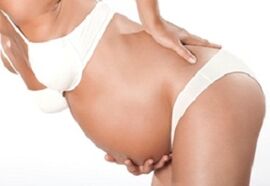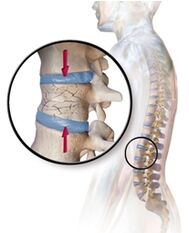Periodic or persistent back pain affects about 80% of the world’s population. The problem occurs more often in women. The symptoms are called lumbodynia. It is very common because of the constant high pressure on the lumbar spine. He experiences a pressure of 50 kg (in the supine position) to 220 kg if the person sits slowly. The problem indicates a lifestyle tendency or a serious illness. With age, it gets worse and can lead to disability of the patient.

Physiological causes for pain
Discomfort in the form of pain is a reaction of the body’s defenses. As a result, he responds to various "abnormal" processes inside, which doctors refer to as pathology. The body aches in an uncomfortable state and after doing physical exercise, tells the brain that it is difficult to complete its task.
Uncomfortable position
Lumbar pain bears prolonged discomfort. The problem worries drivers and office workers, as they spend a lot of time sitting, when the lower back is exposed to maximum pressure. Someone suffers from back pain due to fatigue. If he does something for a long time in a bent state.
Back pain after sleep if the bed is not complete. For example, the surface of the bed is too hard or soft to provide sufficient support to stretch the spine and quality muscles.
The load increases
Muscles and ligaments can ache in the back. They support the spine in a stable position and experience stress with vigorous physical effort. The condition for the occurrence of pain arises with sudden movements, accompanied by muscle tension in the lumbar region. This happens if a person carries a weight, pulls a heavy object, lifts it up and down (bending "in half").
Muscles can also stretch during sports. If a person exercises a lot, his ligaments need time to recover. If there is no good rest, they become tired or become inflamed, which is indicated by the nervous system with pain.
Women's back pain
The problem of lumbar pain is very common among women, as the beautiful half of human beings always experience it in certain circumstances. Menstrual abdominal pain is often accompanied by discomfort in the lower back and sacral area. This is not associated with increased stress, but is a result of the production of prostaglandins (pain mediators). Before and during menstruation, mediator synthesis triggers hormonal changes in the female body.
in the female body.
The lower back of a girl hurts while carrying a child (in 95% of pregnant women). The spine doesn’t just experience tremendous stress outside of pregnancy. The pressure on the lower back increases many times as a woman’s weight increases. The extra load is created by the pregnant stomach. It pulls the pregnant mother’s body forward, changing the axial load distribution. As a result, women's gait changes, lower back pain occurs, its intensity increases according to the duration of pregnancy. The load increases in each position of the pregnant mother, therefore, good rest, lying on a quality mattress is very important to alleviate the condition of the woman.
Hypodynamia
Discomfort often occurs in people who do not play sports or lift heavy objects at all. The reason is the weakness of the muscular apparatus. The back muscles must be strong to support the spine properly and relieve stress from it. If this does not happen, the bone and cartilage tissue will quickly deplete, which is accompanied by pain.
Structural abnormalities
The spine is formed by the skeleton of bone tissue - the vertebrae. Among them there is a soft "layer" of cartilage tissue - the vertebral disc. Vertebrae provide strength and stability, cartilage - flexibility and elasticity of the spine. The main structural elements are perforated in the middle. The canal is lined with spinal cord. All components are surrounded by blood vessels, nerve fibers. Pathology in any element of the lumbar spine causes lumbodynia.
Osteochondrosis
The disease develops when the intervertebral cartilage disc is depleted. Because of a lot of load, the lumbar disc is often damaged. The most common causes of lower back pain are protrusion (decrease) and hernia (damage and protrusion of contents) of the disc, in which the nerve roots of the spine are pinched. Osteochondrosis affects people over the age of 35. The disease often occurs in the elderly.
Trauma
The lumbar spine is considered the strongest because it forms the main "axis" for the entire human body. However, with falling and sudden movements, the spine of this part is most often injured. A large number of fractures and bruises on the spine are located right in the lower back.
Vascular damage
Vessels provide nutrients to all spinal tissues. If their lumens narrow or overlap, the trophic processes in the spine will worsen. As a result, inflammation occurs, which always manifests itself in pain.
Nerve traps
Nerve fibers can be damaged due to damage to the cartilage and spine, in the event of an infectious disease. All nerve pathology is accompanied by sharp shots and back pain that is sometimes unbearable.

Bone disorders
Osteoporosis causes calcium depletion and bone fragility. If the vertebral tissue is depleted, there is an increased risk of serious back injury. In addition, osteoporosis can change the shape of the bones of the spine and increase the pressure on the nerve roots.
Another cause of pain is a tumor on the vertebrae. The most common type is hemangiomas. These benign neoplasms develop asymptomatically for a long time, but when the tumor becomes too large and extends beyond the vertebrae, the patient experiences severe pain.
The inflammatory process
Arthritis can affect any joint in the body. Inflammation leads to joint damage and pain. It can be provoked by advanced and chronic infectious diseases. Another cause of arthritis is autoimmune damage to connective tissue.
Internal problems
The lower back can be sore not only due to spinal pathology. Painful sensations associated with pathology of internal organs or some systemic disease can be given to the lumbar region.
Internal organ
Back pain is associated with kidney damage. Renal colic is accompanied by sharp and sharp pain in one or both parts of the back. More often it is felt under the ribs in the back of the body.
Lumbar discomfort often occurs on the background of intestinal diseases, with inflammation of the pelvic organs (bladder, prostate - in men, ovaries and uterus - in women).
Systemic pathology
Psoriasis and ankylosing spondylitis cause lumbar pain. With this disease, violations occur in the structure of connective tissue (cartilage). It loses its elasticity, and therefore often becomes inflamed. Over time, significant disturbances in joint function occur, and nerve endings are under constant (disrupted) pressure. With ankylosing spondylitis, the intervertebral space "hardens".
Lower back pain can cause herpes zoster. The rash with this disease appears on the shoulder blades, ribs, but most often - on the lateral surface of the trunk in the lumbar region. The pain first appears before significant changes in the skin. When a blistering rash appears, discomfort increases, coupled with itching. Even if the spots disappear completely, a person still experiences severe pain along the inflamed nerve. They can bother the patient for months.
Growth
Malignant lesions of the spinal cord and bone initially do not change the patient’s condition. As the tumor grows and atypical cells spread in the structure of organs and tissues, changes occur where nerves are affected. This is indicated by severe pain. Discomfort in the lower back is felt not only with lesions of the lumbar spine, but also if the tumor grows in internal organs, which are invaded by nerve ganglia from this department.
Nerve Disorders
Lower back pain can be a ghost (in other words, self -created by the patient). This is true with psychoneurotic disorders. The soul does not function well against a background of prolonged shock, stress, psycho-emotional stress. Discomfort can arise if a person instills a disease in himself, suffering from too much work. Such symptoms appear for the first time after depression or neurological disorders and can bother patients for years.
How to get rid of lumbar pain
If an unpleasant sensation occurs in the lower back, the patient should rest completely, reducing the intensity of the load. As a rule, after a good rest, the discomfort disappears or disappears altogether. These are special symptoms of pain caused by improper lifestyle, poor quality rest. If the pain persists, you should consider a visit to the doctor.
The nature of back pain is diagnosed by traumatologists, vertebrologists, orthopedists. You can contact any of the listed specialists. At the first consultation, the doctor will interview the patient, examine him, perform some tests (check nerve sensitivity, muscle condition). If a diagnosis cannot be made based on the information received, additional examinations will be scheduled. To assess the condition of the bone tissue, x-rays are prescribed. The structure of cartilage, nerves, the condition of blood vessels and spinal cord can be assessed by MRI. If the doctor suspects systemic disease, the patient is prescribed laboratory diagnostics (general and biochemical blood and urine tests). Only after making an accurate diagnosis, the specialist will prescribe his treatment.
Drug therapy
The list of drugs depends entirely on the diagnosis. To relieve symptoms quickly, patients will be given short -acting painkillers (usually from the NSAID group). With strong inflammatory and autoimmune changes, glucocorticoid medications are prescribed. For cartilage tissue diseases, chondroprotectors are recommended in injections or tablets. If the problem is with the muscles, muscle relaxation is recommended. To restore the work of nerve endings, vitamin B is prescribed.
The main treatment is aimed at the cause of the pain. If caused by disease of the internal organs, drug therapy will improve the dysfunction of the kidneys, gastrointestinal tract, and genitals. Symptoms will disappear when the underlying disease is eliminated. With unbearable pain, nerve blockade is performed (analgesics are injected directly into the nerve root zone).
To enhance the action of injections or tablets, external painkillers (patches, ointments, gels) can be prescribed. Such medications can be used independently, with recurrent lower back pain against a background of increased tension or stress. To relieve the situation, you can use pepper plaster or bulbs. They are also allowed to be used without a doctor's prescription.
Procedure
For back pain, a specialist may recommend special treatment. These include acupuncture, physiotherapy with electric current, ultrasound, therapeutic ultraviolet rays. In some cases, exercise and physiotherapy sequences are indicated. If the vertebrae are moved, the help of a chiropractor may be needed to arrange the bone back into place. Any procedure must be chosen in conjunction with the physician. It is forbidden to undergo treatment in which they act directly on the spine, without diagnosing the disease. In this case, the procedure is not only useless, but also endangers the patient.
To prevent back pain, you need to monitor the health of your spine from a young age. It is important to do the load correctly on the back (to lift the object squatting, and not bending, pushing a heavy object, and not pulling it towards you) You should do moderate physical activity and choose exercises with a trainer. It is also important to treat infectious diseases in a timely manner, avoid stress, take medication reasonably and as prescribed by a doctor.












































